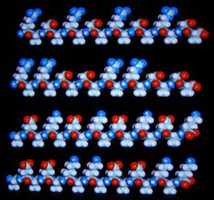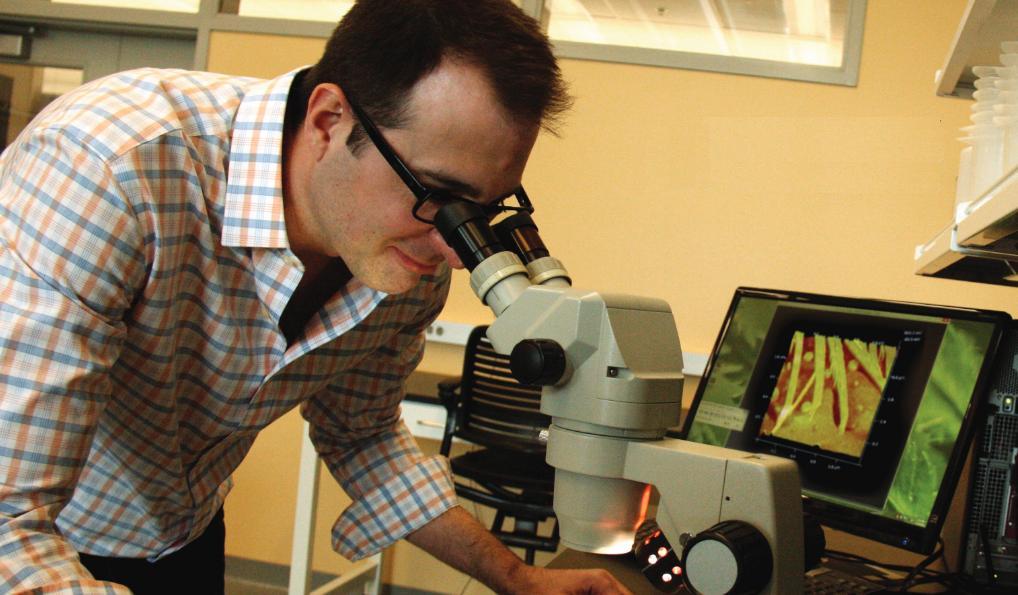/ News

Researchers Combine Ideas of 3D Printing With Molecular Self-assembly – Is Molecular Manufacturing Next?
What’s the ultimate extension of 3D printing technology? Where could 3D printing take us in the future? For me, I believe that eventually, whether it’s in my lifetime or not, we will have nano-factories, 3D printing at the molecular level. I envision a future where we are able to turn our garbage into just about anything we want, via a sophisticated computer system, along with hardware capable of breaking any mass down to its molecular level, before using those molecules to construct a brand new object.
Yes, I realize that many of you are probably thinking, “Why am I reading this article from this kook?” However, a couple of researchers including Justin Barone, an associate professor of biological systems engineering at Virginia Tech, and Ryan Senger, an assistant professor, have taken the first steps towards such a future.
The two men have combined the ideas of 3D printing with that of molecular self assembly to create a process which they call ‘genetic 3D printing’. For those who are not biologists, molecular self assembly is simply the process in which molecules arrange themselves in a particular order without guidance from an outside source. Molecular self assembly is a bottom-up approach like that of 3D printing.
The discovery, which was accidental, allowed the researchers to create proteins which have the ability to self assemble into fibers. The discovery was made while they were simply trying to produce gluten adhesives, by cutting out a section of the gluten protein. What happened next surprised them. When the section of the protein was removed, fibers self assembled themselves in the beaker.
“I immediately thought it was a mistake,” Barone said. “I thought the student, who was losing his hair, was losing hair all over the lab and told him to wear a hair net. So he did it again and was more careful and got fibers again. This time, I had them vacuum the whole lab and all the air ducts because I thought it was coming from the vents or something. But we got them again. So we started to study them and realized we had something big.”

Researcher Justin Barone. (Image credit: http://www.research.vt.edu)
The quality of the fibers were on par with those produced by silk spiders, something which researchers have been trying to produce for years. Spider silk has a strength-to-weight ratio which is five times that of steel, making it an ideal material for all sorts of applications.
The researchers went back and realized that they can manipulate the protein structures of the fibers to change their colors, but this wasn’t all. By combining the gluten protein with other proteins, they are able to molecularly print fibers with varying electrical properties, strengths and colors. In ordinary 3D printing, individuals use a software to translate a computer code and raw material into a physical object. In this case the researchers found that they were able to use a genetic blueprint as their computer code and back-calculate the DNA, which was inserted into a host bacterium, in this case e-coli. From there, the protein (raw material) grew, left the cell, and interacted with one another to build the fibers which the researchers had predetermined.

If this seems amazing, both Barone and Senger believe that they could eventually utilize this method as a way to molecularly manufacture all sorts of objects. Because the protein fibers are natural building blocks, once a method is figured out in which they are able to get the fibers to organize into larger structures, anything could be possible. From a coffee pot, to human bone, or even muscle, the researchers believe that one day this method of 3D printing fibers could manufacture it all.
The researchers are currently working to further their discovery, and produce the silk-like fibers in large quantity for a variety of uses. Additionally they are looking for ways to increase the size of each fiber, eventually enabling the manufacturing of larger objects.
“All of the fibers have the same fate: to end up in an engineered product that we will eventually genetically 3-D print,” Barone said. Let’s hear your thoughts on this type of ‘genetic 3D printing’ in the 3D printed fiber forum thread on 3DPB.com. [Source: vt.edu]
Source: http://3dprint.com/11243/genetic-3d-printing-fibers/
/ About us
Founded by Russian entrepreneur Dmitry Itskov in February 2011 with the participation of leading Russian specialists in the field of neural interfaces, robotics, artificial organs and systems.
The main goals of the 2045 Initiative: the creation and realization of a new strategy for the development of humanity which meets global civilization challenges; the creation of optimale conditions promoting the spiritual enlightenment of humanity; and the realization of a new futuristic reality based on 5 principles: high spirituality, high culture, high ethics, high science and high technologies.
The main science mega-project of the 2045 Initiative aims to create technologies enabling the transfer of a individual’s personality to a more advanced non-biological carrier, and extending life, including to the point of immortality. We devote particular attention to enabling the fullest possible dialogue between the world’s major spiritual traditions, science and society.
A large-scale transformation of humanity, comparable to some of the major spiritual and sci-tech revolutions in history, will require a new strategy. We believe this to be necessary to overcome existing crises, which threaten our planetary habitat and the continued existence of humanity as a species. With the 2045 Initiative, we hope to realize a new strategy for humanity's development, and in so doing, create a more productive, fulfilling, and satisfying future.
The "2045" team is working towards creating an international research center where leading scientists will be engaged in research and development in the fields of anthropomorphic robotics, living systems modeling and brain and consciousness modeling with the goal of transferring one’s individual consciousness to an artificial carrier and achieving cybernetic immortality.
An annual congress "The Global Future 2045" is organized by the Initiative to give platform for discussing mankind's evolutionary strategy based on technologies of cybernetic immortality as well as the possible impact of such technologies on global society, politics and economies of the future.
Future prospects of "2045" Initiative for society
2015-2020
The emergence and widespread use of affordable android "avatars" controlled by a "brain-computer" interface. Coupled with related technologies “avatars’ will give people a number of new features: ability to work in dangerous environments, perform rescue operations, travel in extreme situations etc.
Avatar components will be used in medicine for the rehabilitation of fully or partially disabled patients giving them prosthetic limbs or recover lost senses.
2020-2025
Creation of an autonomous life-support system for the human brain linked to a robot, ‘avatar’, will save people whose body is completely worn out or irreversibly damaged. Any patient with an intact brain will be able to return to a fully functioning bodily life. Such technologies will greatly enlarge the possibility of hybrid bio-electronic devices, thus creating a new IT revolution and will make all kinds of superimpositions of electronic and biological systems possible.
2030-2035
Creation of a computer model of the brain and human consciousness with the subsequent development of means to transfer individual consciousness onto an artificial carrier. This development will profoundly change the world, it will not only give everyone the possibility of cybernetic immortality but will also create a friendly artificial intelligence, expand human capabilities and provide opportunities for ordinary people to restore or modify their own brain multiple times. The final result at this stage can be a real revolution in the understanding of human nature that will completely change the human and technical prospects for humanity.
2045
This is the time when substance-independent minds will receive new bodies with capacities far exceeding those of ordinary humans. A new era for humanity will arrive! Changes will occur in all spheres of human activity – energy generation, transportation, politics, medicine, psychology, sciences, and so on.
Today it is hard to imagine a future when bodies consisting of nanorobots will become affordable and capable of taking any form. It is also hard to imagine body holograms featuring controlled matter. One thing is clear however: humanity, for the first time in its history, will make a fully managed evolutionary transition and eventually become a new species. Moreover, prerequisites for a large-scale expansion into outer space will be created as well.
Key elements of the project in the future
• International social movement
• social network immortal.me
• charitable foundation "Global Future 2045" (Foundation 2045)
• scientific research centre "Immortality"
• business incubator
• University of "Immortality"
• annual award for contribution to the realization of the project of "Immortality”.



 LinkedIn
LinkedIn
 LiveJournal
LiveJournal
 Google
Google
 Twitter
Twitter
 Facebook
Facebook
 Я.ру
Я.ру
 ВКонтакте
ВКонтакте
 Mail.ru
Mail.ru